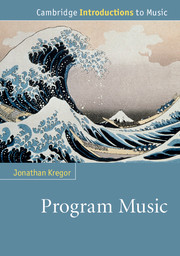Book contents
- Frontmatter
- Contents
- List of Figures
- List of Music examples
- List of Tables
- Acknowledgments
- Note on the text
- Introduction
- Chapter 1 Characters, topics, and the programmatic battlefield
- Chapter 2 Expression, musical painting, and the concert overture
- Chapter 3 Berlioz and Schumann on music and literature
- Chapter 4 Liszt and the symphonic poem
- Chapter 5 The New German School and beyond
- Chapter 6 Excursus: Faust
- Chapter 7 Programmatic paths around the fin de siècle: Mahler and Strauss
- Chapter 8 Programming the nation
- Chapter 9 “Ars Gallica”
- Notes
- Guide to further reading
- Index
Chapter 8 - Programming the nation
Published online by Cambridge University Press: 05 January 2015
- Frontmatter
- Contents
- List of Figures
- List of Music examples
- List of Tables
- Acknowledgments
- Note on the text
- Introduction
- Chapter 1 Characters, topics, and the programmatic battlefield
- Chapter 2 Expression, musical painting, and the concert overture
- Chapter 3 Berlioz and Schumann on music and literature
- Chapter 4 Liszt and the symphonic poem
- Chapter 5 The New German School and beyond
- Chapter 6 Excursus: Faust
- Chapter 7 Programmatic paths around the fin de siècle: Mahler and Strauss
- Chapter 8 Programming the nation
- Chapter 9 “Ars Gallica”
- Notes
- Guide to further reading
- Index
Summary
Mendelssohn’s Scottish complex and Liszt’s German Hungaria
On 7 August 1829, from the town of Tobermory in the Scottish Inner Hebrides, Felix Mendelssohn dispatched a letter to his family that contained the first twenty-one measures of what would become his “Hebrides” Overture. The next day he and his traveling companion, Karl Klingemann, sought out Fingal’s Cave, a picturesque destination made popular by James Macpherson’s “translations” from the 1760s of the ancient Scots-Gaelic bard Ossian. Composition and revision occupied Mendelssohn for more than five years after his visit to the Hebrides, and he never did settle on a definitive title for one of his most admired orchestral works: On 11 December 1830 he described the work as an Ouverture zur einsamen Insel (Overture to the Solitary Island), five days later as Die Hebriden (The Hebrides); it was premiered by the Philharmonic Society in London on 14 May 1832 as The Isles of Fingal, a title Mendelssohn also sanctioned for the London publication sixteen months later of the four-hand piano arrangement. On the continent, however, that same edition appeared as Ouverture aux Hébrides (Fingals Höhle) (Overture to the Hebrides [Fingal’s Cave]). Orchestral parts appeared in June 1834 for Die Hebriden, while the full score from April 1835 advertised itself as Die Fingals-Höhle. However, one constant among the myriad titles Mendelssohn vetted is his subject matter’s exotic distance from its intended European audience. Indeed, few figures captivated readers (and listeners) as forcefully in the late eighteenth and nineteenth centuries: A long-dead, quasi mythic poet (Ossian) chronicles the deeds of his father (Fingal) in a mysterious, long-abandoned realm (Fingal’s Cave) in a remote part of the Western world (the Hebrides).
- Type
- Chapter
- Information
- Program Music , pp. 227 - 252Publisher: Cambridge University PressPrint publication year: 2015

